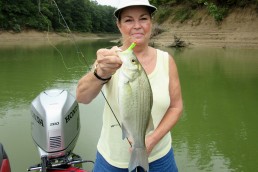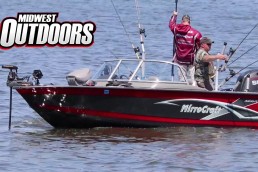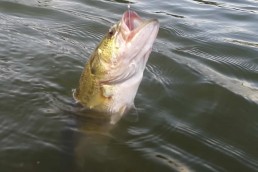Power Fishing
SHARE THIS POST
If this isn’t already part of your current mindset, you need to start fishing for bass based on the fish’s seasonal movements and patterns rather than angling from the human standpoint.
So what do I mean by this?
Bass know nothing about specific months of the calendar or that our seasons are referred to as winter, spring, summer or fall. For these fish, they migrate, feed, spawn and gather in certain areas based on water temperatures and water conditions. Other factors do influence and affect the behavior of bass—weather fronts, forage availability, water clarity, oxygen content—and have a part in determining their behavior on any given day, but water temperature is what controls much of their willingness to bite since they are a cold-blooded creature.
So, with this in mind, this and most future articles will focus on bass activity levels based on seasonal tendencies, which leads to this month’s concept for the bank-angling basser: power fishing.
Here in the Midwest, bass are either just coming off the spawn or are possibly still on beds—once again, it depends on water temperatures. I’m suspecting with the lack of winter again, earlier-than-usual spawn occurred. Whatever the circumstance is on your body of water, once the mating rituals have been completed and love is no longer in the air, or water in this case, the bass begin their journey from the skinny-water areas of the spawn to their summer residences of the deep. Power fishing now becomes one of the most successful techniques to search for and catch these fish.
There are power-fishing presentations and baits, but let’s first narrow down the target areas to check for post-spawn bass.
As bass exit spawning grounds, they go into a short rest period, and then the urge to feed kicks in. While it’s not quite time for these to school in large numbers in the depths, you’ll find singles and smaller packs and schools foraging and cruising in water from a few inches deep to hunting along weedlines to chasing bait in open water. Whatever the case, bass are on the move and so should the bank-bass angler.
The rule is not to get fixated on any one type of structure or pattern. And even if you do catch a bass or two, keep covering varying depths, as these fish will be moving in and out of most locations. Covering lots of water is when power fishing proves its worthiness.
Power fishing has been practiced by tournament bass pros for years. Kevin VanDam is probably labeled as “the king of power fishing” and has turned this method into a year-round technique—making him a threat to take home the trophy no matter the body of water he’s on. He has become one the most popular bass anglers of all time, and has gained fame and fortune by perfecting his form of power fishing.
Power fishing to me is not about the speed at which you retrieve your bait; it’s about covering as much water as possible with every cast while making sure the bait runs true to its purpose. To cover these large expanses of water, you’ll need to throw those baits designed for such a purpose.
Are you enjoying this post?
You can be among the first to get the latest info on where to go, what to use and how to use it!
If you have your own favorites, please use them and tell us. Here are some of my choices for the bank basser:
Power Fishing Bait 1: The River2Sea’s Whopper Plopper 90. Last month we featured this bait, but this is one of my top power-fishing baits for bank bassing. Since I did cover this bait in depth before, I won’t spend too much time dwelling on its characteristics. Since this is a surface bait, you can run it through mere inches of water, but still draw attention from deeper, more open-water situations with bass rising to hit this offering. Keep the bait moving with an occasional snap of the rod tip to cause the bait to throw a bit more water to break up the constant retrieve.
Power fishing Bait 2: Lipless crankbaits, like Strike King’s Red Eye Shad, Rapala Rattlin’ Rap, Bill Lewis’ Rat-L-Trap, are part of a bunch out there, and allow you to make extremely long casts. These offer you the ability to cover various depths depending on your retrieve speed. You might think this bait needs to stay away for the weeds, but it’s quite the opposite. While not made for thick or heavy weeds, ripping these baits through sparse grass and weeds is an awesome technique. Once you feel the weeds, just rip your lure through the weeds; this is where the majority of strikes will occur. As with most of my retrieves on these types of baits, don’t get into the habit of just a constant straight retrieve. Instead, allow the bait to sink on the pause then rip it up to speed—an erratic cadence will catch more fish.
Power Fishing Bait 3: Shallow-running crankbaits are ideal as well, and my two favorites are Rapala’s Shallow Shad Rap and Strike King’s KVD Square Bill. These baits run in that surface to 5-foot range, depending on retrieve speed. Bass are feeding on smaller fish in June, and these crankbaits mimic that forage. While I run the Shallow Shad Rap in relatively open water while ticking some vegetation on occasion, as with the Strike King Square Bills, they don’t hesitate to bounce off of hard objects like wood, rocks, concrete or anything that will allow the bait to deflect once it strikes an object. Bass respond very intensely to this change of speed and direction with this bait.
Power Fishing Bait 4: The soft plastic swimbaits some in a variety to choose from, but I fish primarily the Keitech Swing Impact FAT Series in the 3- to 4-inch size. Rigged with either a swimbait jig head or a swimbait weighted hook, I’ll work these baits just as I would a crankbait. For hooking preference, I like the swimbait hook over the jig head at this point because I can use them in areas of weeds, and with less fouling. If I’m in more open-water areas and distance is a necessity, I’ll then switch to an appropriate jig head.
Power Fishing Bait 5: The Z-MAN ChatterBait has been around for a while and has been producing great catches. If you have never used one, it’s basically a bass-type jig with a flat blade attached to the front of the bait. It puts out an incredible vibration and there’s really no way to fish it wrong. Experiment with different trailers attached to the jig’s hook; I’ve been using plastic swimbait bodies with success instead of the plastic trailers provided. Except for the Whopper Plopper, these baits can all be run in the 1- to 5-foot range to search for post-spawn feeding bass, which is my main focus right now.
Here’s another concept to think about for power fishing and in regard to most of the time pursuing bass from a bank: parallel the bank as much as possible with casts. This allows the maximum time for your bait to pass through active-fish feeding depths opposed to casting straight in front and your bait only going through the active zone for only a few feet. The diagram provided will show how to fan-cast from the bank to straight out to cover the most water possible in each casting area. Once this zone is covered, move forward.
Another suggestion on casting from the bank to cut down on casting hazards is to keep the open water to the outside of your casting arm. In other words, as you parallel the bank with your casts, you’re actually either facing right or left down the bank, and not facing open water. Depending on whether you cast left- or right-handed, keep your casting shoulder facing open water. For example, I cast right-handed. But when I can, I’ll move clockwise around a lake or a pond to keep the water on my right shoulder.
So, as the bass journey from the shallows to their deeper warm-water locations in late spring and early summer, use power-fishing baits and techniques to appeal to their desire to pack on the weight before settling in to their seasonal patterns.
MWO
SHARE THIS POST
Did you enjoy this post?
You can be among the first to get the latest info on where to go, what to use and how to use it!
Dan Brozowski
Passion for angling drives Dan Brozowski to the water’s edge virtually any chance he gets. Although passion cannot be measured, weighed, or recorded, it can be shared. He does this through his writing and while on the water. If you have any questions or comments for Dan, you may contact him at: onthebank@att.net.



